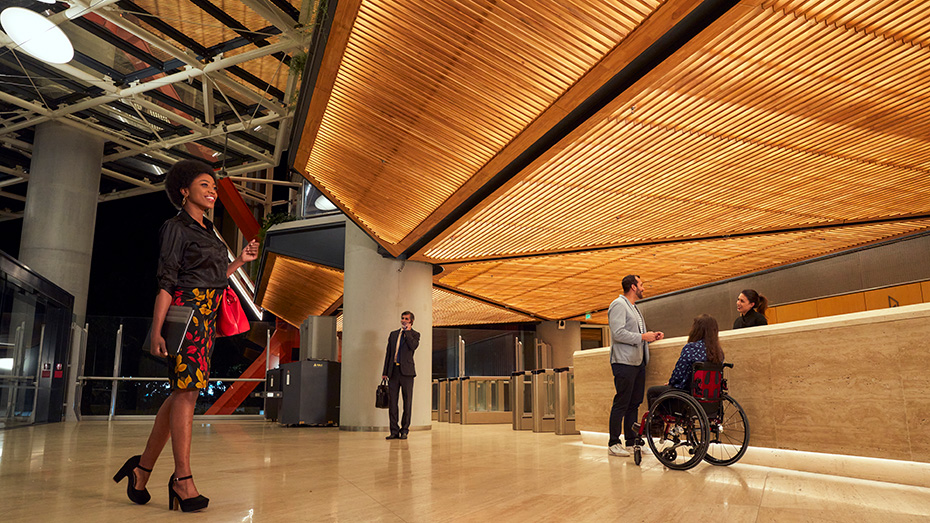Contributing to a more accessible and inclusive world | Otis
How engaging the disability community helps Otis contribute to a more accessible and inclusive world
- December 12, 2024

By Christy Vanek, Director, Global Disability Accommodations & Accessibility, Otis Worldwide Corporation
Digital technology and mobility are converging in exciting new ways to enhance urban environments and improve physical accessibility.
New wayfinding apps designed for widespread use are helping people who are blind or visually impaired navigate buildings with audio cues. They can also direct people with mobility disabilities to stair-free routes.
Autonomous robot technology is enabling passengers with reduced mobility to use robotic wheelchairs to move through airports independently.
And electric vertical take-off and landing vehicles (eVTOLS), sometimes called air taxis, are on the horizon for accessible city transport.
These are just a few examples of how emerging technologies are shaping the future of urban mobility. At Otis Worldwide Corporation, the global leader in elevator and escalator manufacturing and service, one of our goals is to make it easier to navigate urban environments, and we aspire to work so that any new technology can benefit everyone – including people with disabilities.
We do this by making accessibility a critical component of our innovation strategy, listening to input from customers and passengers, including those with disabilities, and ingraining accessibility and inclusion into our corporate culture, in line with our business strategy and product roadmap.
Why? Because 1.3 billion people worldwide – more than one in six – currently experience a significant disability, according to World Health Organization estimates. That number is only going to increase as the global population ages. And as more people move to urban areas and cities grow larger, accessible mobility in cities and buildings becomes even more crucial.
Accessibility has been part of elevator design since the beginning.
Elisha Graves Otis' invention of an elevator safety brake launched an industry, with new ways for cities to grow upward and people to move safely. Initially intended for hoisting heavy goods – not people – so-called “safety elevators” soon had human passengers who used them for convenience, amusement, or necessity. As buildings grew taller and modern cities began to take shape, elevators became an expectation in buildings higher than seven floors.
Elisha Graves Otis demonstrating his safety brake in 1854.
This connection to accessibility continues in Otis’ modern-day product development strategy.
In 2023, our Engineering team searched for ways to improve accessibility of car operating panels – elevator buttons. They considered a number of suggestions from colleagues around the globe, and members of our Thrive Employee Resource Group, which focuses on disability, mental health and well-being, helped to review the ideas. We continue to iterate on the best of these ideas, striving to bring advances to accessibility to the market.
Otis is also working directly with organizations for people with disabilities.
In June, I joined Otis representatives at the Foundation Fighting Blindness VISIONS conference in Chicago, showcasing the newest hall fixtures for our Compass® destination dispatching system.
Like other Otis dispatching systems, it uses a touch screen for passengers to select their desired floor, and it manages traffic more effectively than a conventional up/down button system. Touch screens aren’t accessible for many blind and low-vision users, and the original model included a single physical button as an alternative call mechanism for ADA accessibility. It worked, but like other similar systems, was a bit cumbersome. We saw an opportunity to improve the user experience.
The new model has three physical buttons – down, up, and select, and is much more intuitive and efficient. At the conference, Otis tested this fixture with blind and low-vision users and received excellent feedback on how to further advance our design.
Otis trialed its new, three-button Compass destination dispatching fixture at the Foundation Fighting Blindness VISIONS conference in 2024.
Best of all, our accessibility technology was in use at the conference.
Before the event, the Foundation Fighting Blindness and the hotel hosting the conference approached Otis and asked us to modify the existing Otis® elevators to make them easier to use for blind and low-vision passengers. We installed speakers and software to play audio announcements that tell passengers what floor they are on and the direction of travel. This low-tech solution can be added to new and existing elevators and makes a world of difference.
A video showing the audio announcements on elevators at the Foundation Fighting Blindness VISIONS conference.
An inclusive, accessible workplace is a springboard to innovation.
It’s no surprise that our Engineering team is observing the current trends in urban mobility and searching for ways Otis can integrate to better serve the riding public. It’s also no surprise that our Thrive Employee Resource Group was invaluable in our efforts to improve accessibility of elevator buttons. In fact, the group has helped promote accessibility in our product development – so that innovation helps create a more accessible world.
Inclusion and accessibility are important parts of our company culture. Otis strives to create an inclusive work environment that enables us to attract the best candidates and support them. Our global workplace adjustment and reasonable accommodation process is designed to provide a simple and easy-to-access process for our colleagues to submit requests. We recently signed on to the Disability:IN Procure Access Statement to help incorporate accessibility into our technology procurement and vendor selection processes. And we are signatories to the Disability:IN CEO Letter on Disability Inclusion.
Our vision is to give people freedom to connect and thrive in a taller, faster, smarter world, and we’re doing that by embedding inclusion and accessibility into our business strategy and product roadmap.
